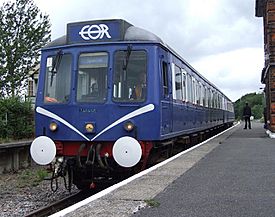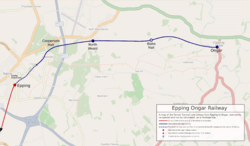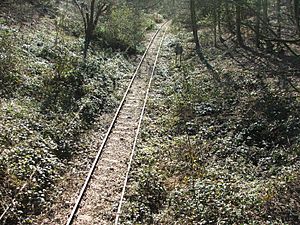Epping Ongar Railway facts for kids
Quick facts for kids Epping Ongar Railway |
|
|---|---|
 |
|
| Locale | Essex |

Services end at Coopersale Halt, but it is planned for the line to go to Epping in the future.
|
|
| Commercial operations | |
| Original gauge | 1,435 mm (4 ft 8 1⁄2 in) (Standard gauge) |
| Preserved operations | |
| Owned by | Epping Ongar Railway Ltd. |
| Length | 10 km (6.2 mi) Single track throughout except a passing loop in North Weald |
| Preserved gauge | 1,435 mm (4 ft 8 1⁄2 in) (Standard gauge) |
| Commercial history | |
| Opened | 1865 |
| Closed | 1994 |
| Preservation history | |
| 2004 | Re-opened |
The Epping Ongar Railway is a special preserved railway in Essex. It uses part of an old railway line that once belonged to the Great Eastern Railway and the London Underground Central line. This line runs between the towns of Epping and Ongar. There is also a stop in the middle at North Weald.
The railway was closed for 10 years before it reopened in late 2004. Today, it runs train services on Sundays and Bank Holidays. These services use a Class 117 diesel train. The trains travel between Ongar and Coopersale. Many dedicated volunteers help run the trains and take care of the railway line. The land and railway equipment are owned by a company called Epping Ongar Railway Ltd.
Contents
How the Railway Started

The railway line to Ongar was first built in 1865. It was created by the Eastern Counties/Great Eastern Railway. The section of the line between Epping and Ongar had only one track. There was a special passing loop at North Weald station. This loop allowed trains going in opposite directions to pass each other. About 14 trains traveled to Ongar station every day. Other trains ended their journey at Epping or Loughton.
Trains continued to end at Epping or Loughton until 1949. At this time, the London Passenger Transport Board extended the Central line to Epping. This meant electric trains could now reach Epping. The Central Line then took over the railway from British Rail. As part of this change, direct trains from Ongar to London were stopped. Instead, a shuttle service ran between Epping and Ongar. Passengers would change trains at Epping to continue their journey to London.
For a while, you could see steam trains and London Underground electric multiple units side-by-side at Epping. The London Transport Executive rented the steam shuttle from British Rail. This was because it was too expensive to add electricity to the line all the way to Ongar. Not many passengers used this part of the line, so the cost was not justified.
In the 1950s, there were efforts to make the service better. The line was finally given permission to be electrified in 1957. However, because the electrification was done cheaply, only short trains could run on it. The power supply was not strong enough for longer trains. Also, the stations on the line had short platforms. This meant that the usual 8-car trains could not stop there. Because of these reasons, the Epping-Ongar branch line usually ran separately from the rest of the Central Line.
However, for two days each year, special trains did run directly from London. These trains would stop at North Weald for the airshow on the Saturday and Sunday. The regular Epping-Ongar shuttle would get around this extra service. It would pass the London train on the other line at North Weald station. This extra train from London was only four carriages long, not the usual eight.
Why the Railway Closed
By the late 1960s, it was clear that not as many people were using the line as expected. New buildings were not allowed in the area because it was now Green Belt land. This meant fewer people moved there who might use the train. The number of passengers reached its highest point in 1971, but it was still only 650 people each day. This meant the railway was not making much money.
London Underground tried to close the whole line in 1980, but they were not allowed to. Instead, they ran fewer trains. They also closed Blake Hall tube station on Sundays.
Blake Hall station was permanently closed in 1981. Before it closed, only about six passengers used the station each day. The old station building is still there, but it is now a private house. The platform was removed, but it was partly rebuilt in 2015.
North Weald station's platform one was closed in 1976. The passing loop and the tracks going west were removed in 1978. Before this, special semaphore signals controlled access to the two platforms. These signals were operated from the original Eastern Counties Railway signal box. This signal box is still on the southbound platform. North Weald was the last part of the London Underground network to use these old-style signals.
The railway line was losing about seven pounds for every passenger journey. It also needed expensive repair work. So, on 30 September 1994, the line was closed to the public. The Central Line trains then ended their journey at Epping station. When the line closed, only about 80 passengers were using it each day. Some local stories said the line was kept open in case important government officials needed to be moved to a nuclear bunker at Kelvedon Hatch.
A special three-car train, called 1960 stock, was preserved by Cravens Heritage Trains. This was the train that ran the very last London Underground service on the line.
Buying and Reopening the Line
The railway line was bought in 1998 by a company called Pilot Developments. This company is now known as Epping Ongar Railway Ltd. Another group, the Ongar Railway Preservation Society, also tried to buy the line. Their offer was £339,500. However, Pilot Developments offered the same amount, and London Underground accepted their offer. Martin Bell, a politician who was not part of a main political party, said this was a very debated land deal. He mentioned that there might have been a conflict of interest with local politicians.
The railway line reopened on Sunday, 10 October 2004. It is now run by the Epping Ongar Railway Volunteer Society. At first, trains ran every hour between Ongar and North Weald. Soon after opening, the line was extended to Coopersale. However, passengers cannot get off the train at Coopersale yet.
From January 22 to April 9, 2006, the line was closed for important engineering work. This work included fixing up the stations, maintaining the trains, and repairing the tracks. Ongar station stayed closed for more work and reopened on Sunday, May 28, 2006. At first, people could not use the station buildings.
At the end of 2007, the railway was sold to a new private owner. This happened because permission was given to build houses near Ongar. The new owner wants to bring steam trains back to the line.
In early 2008, the line was closed to passenger trains again. This was for major engineering work. This work will allow steam trains to run on the line. To make this happen, things like run-around loops and new signals need to be built.
Heritage Railway Trains
In 2006 and 2007, passenger services on the heritage line used a Class 117 diesel train. This train is currently being fixed up, along with a Class 205 DEMU. A Class 37029 train is currently running, as well as 03170. The line also has a selection of Mk1 and Mk2 coaches.
The railway also has some small diesel shunting engines. One is a Drewry shunter (number D1995), named "Heather". There are also two Ruston 88 shunters. One (RH 512572) is working, and the other (RH 398616) is used for spare parts and display. The line uses a Harsco tug unit called "Badger" for engineering jobs. The Epping Ongar Railway also has a small works trolley, a Shark brake van, a Dogfish ballast hopper, and a box van for track maintenance.
At one time, the line owned two trains of 1962 tube stock. Units 1616 and 1491 (which formed an eight-car train) were bought in 1996. Unit 1744 was bought in 1998. Sadly, these trains were badly damaged by vandals. They were taken away to be cut up for scrap metal in 1998 and 2003.
Images for kids
-
The little-used Blake Hall station, which was said to have only six customers a day, closed in 1981. It is now a private home.








